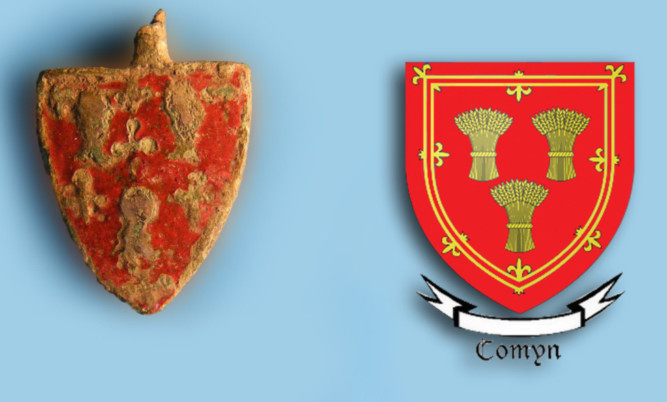A small gold badge found on a Kinross-shire farm could have belonged to a key figure in Scottish history.
The tiny red and gold object was found during an organised metal detecting outing and is a medieval horse-harness pendant dating to around the 14th century.
The finder, John Eldridge, believes it once belonged to Sir John Comyn, Lord of Badenoch and Lord of Lochaber, who took back Loch Leven Castle from occupying English forces in 1301.
Sir John, who was also known as the Red Comyn, was the son of one of the many contenders to the Scottish throne following the death of Alexander III and his granddaughter the Maid of Norway.
He was later murdered before the altar of a Dumfries church by Robert the Bruce, who just six weeks later would be crowned King of Scotland.
Mr Eldridge, who lives in North Berwick, believes that the crest on the pendant matches that of Sir John Comyn and, based on where it was found, could have fallen from the bridle of his horse.
He uncovered the priceless artefact near Loch Leven using his Whites V3i metal detector during a group outing on February 3.
The 67-year-old said he was “over the moon” at the importance of the find.
“I’ve been doing this for over 30 years,” he said.
“I would think this is probably the most important thing I’ve found.”
The pendant, which is around the size of a prefect’s badge, was in such good condition that when Mr Eldridge first dug it out of the ground he thought he had stumbled upon something more recent.
He said: “The enamel was so good I thought it was from the 1950s or 1960s.
“It’s been in the ground for more than 700 years. I did some research and found the crest of the Comyn family. It’s very similar to that it has three sheaves of wheat in silver, but the pennant is in gold.
“The only people who were allowed to wear gold (at that time) were earls and above.”
Mr Eldridge believes that historical data backs up his theory.
He said: “If it is what I think it is then it’s an important part of Scottish history.
“Edward I laid siege to Loch Leven Castle in 1301 and the man that took the Scots army that relieved it was John Comyn. The Comyn coat of arms and the fact that John Comyn was in the area it’s not definite but I’m 90% sure.”
The exact location of the discovery is being kept secret to prevent “nighthawks”, which Mr Eldridge described as “common thieves”, from digging up the land without permission and stealing valuable artefacts.
The find has now been passed on to Treasure Trove Scotland, a body which ensures that objects of cultural significance from Scotland’s past are protected for the benefit of the nation.
A spokeswoman for Treasure Trove Scotland said: “There is little doubt that harness pendants were prominent symbols of status during the medieval period, sending out a clear message about the prestige of the rider, a knight, as well as their family connections or allegiances.”
It is expected that the pendant will eventually be allocated to a local museum.
